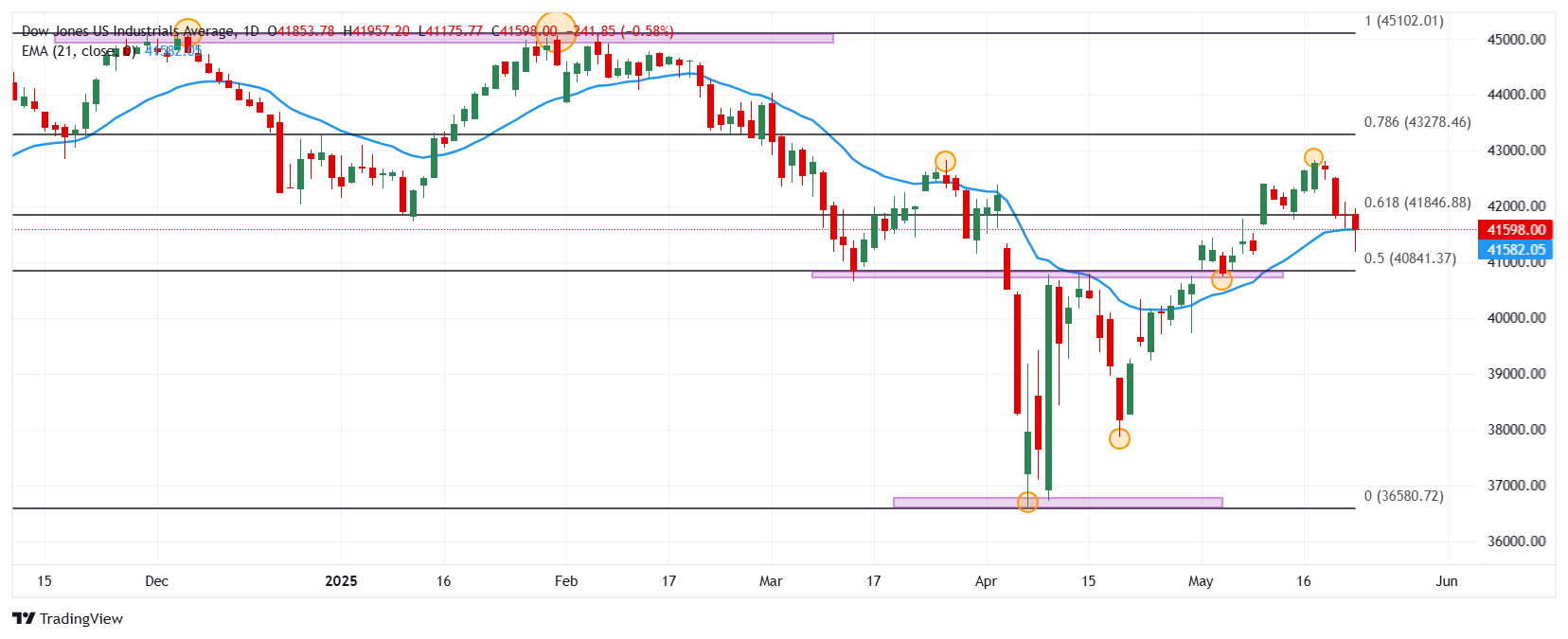- The Dow Jones falls 0.58% daily, reaching minimum of May 9 in 41175.
- The Nasdaq 100 goes back 0.93% in the day, dragged by Workday (Wday).
- The S&P 500 falls 0.67% on Friday, reaching minimums not seen since May 12 in 5,742.
- Donald Trump increased commercial tensions by suggesting a 50% tariff to products from the European Union.
- The president of the Fed of St. Louis, Alberto Musalem, showed his concern to possible increase in long -term inflation expectations
The Dow Jones reacted upward from May 9 in 41,175, finding buyers who took the index to a daily maximum in 41,784.
The industrial average Dow Jones opened in 41,746, while the Nasdaq 100 technological index began operating at 21,161. The S&P 500 initiated the negotiations in 5,846, with a clear bearish perspective.
The Dow Jones falls to a minimum of two weeks dragged by Salesforce
The Dow Jones index falls 0.41% on Friday, operating when writing about 41,695.
Apple shares (AAPL) record a loss of 3.04% in the day, visiting May 7 at 193.46, signing eight consecutive days down.
Apple is suffering from Trump’s commercial rhetoric, noting that it prefers that the products sold in the United States be manufactured within the country, causing an AAPL drop after their statements.
Following the bassist perspective, the Salesforce (CRM) values go back 3.52% daily, reaching minimums not seen since May 6 in 271.65 $.
The Dow Jones falls 265, losing 0.58%, signing its fourth consecutive day down.
Workday and Copart lead the falls in Nasdaq 100
The Nasdaq 100 technological index decreased 0.96% today, visiting May 12 minimums in 20,675.
Workday values (WDay) collapse 12.41% on Friday, reaching minimal not seen since April 28 in $ 237 after the publication of your profit report.
Wday obtained revenues for 2.24 billion dollars compared to the 2.22 provided by the consensus of analysts, as well as an action for action 2.23 $ compared to the $ 2,007 provided by the market. Despite exceeding expectations, investors showed their concern and punished Wday for a growth projection lower than expected.
Copart shares (CPRT) lose 11.52% daily, reaching minimums not seen since April 7 at $ 53.33, signing their fifth consecutive day down.
The Nasdaq 100 falls 195 points, operating when writing about 20,915.
The S&P 500 extends its losses in the midst of new tariff threats
The president of the United States, Donald Trump, has increased commercial tensions again by suggesting a 50% tariff to products from the European Union, dragging the main stock market indices to a negative zone.
In this context, the president of the St. Louis Federal Reserve, Alberto Musalem, showed his concern to point out that commercial uncertainty has caused companies to project higher prices for their products, trying to manage modifications in supply chains.
The S&P 500 falls 38 points, signing its fourth consecutive day down, in tune with the main stock market rates.
The Outdoor Corporation (Deck) Deckers values lead the falls in S&P 500, losing 19.86%, visiting minimal not seen since April 4 at 96.10 $.
Technical Analysis of Dow Jones
The Dow Jones established a short -term resistance given by the maximum of May 19 in 42,832. The next key resistance is 45,068, a pivot point of January 31. To the south, the closest support is in 40,747, minimum of May 6, in convergence with the 50% fibonacci setback.
Dow Jones daily graphics

Dow Jones Faqs
The Dow Jones Industrial Avenge, one of the oldest stock market indexes in the world, consists of the 30 most negotiated values in the United States. The index is weighted by the price instead of capitalization. It is calculated by adding the prices of the values that compose it and dividing them by a factor, currently 0.152. The index was founded by Charles Dow, also founder of the Wall Street Journal. In recent years it has been criticized for not being sufficiently representative, since it only follows 30 companies, unlike broader rates such as S&P 500.
There are many factors that promote the Dow Jones Industrial Average (DJIA) index. The main one is the added performance of the companies that compose it, revealed in the quarterly reports of business benefits. The American and world macroeconomic data also contribute, since they influence investor confidence. The level of interest rates, set by the Federal Reserve (FED), also influences the DJia, since it affects the cost of credit, on which many companies depend largely. Therefore, inflation can be a determining factor, as well as other parameters that influence the decisions of the Federal Reserve.
Dow’s theory is a method to identify the main trend of the stock market developed by Charles Dow. A key step is to compare the direction of the Dow Jones Industrial Avenge (DJIA) and the Dow Jones Transportation Average (DJTA) and just follow the trends in which both move in the same direction. The volume is a confirmation criterion. The theory uses elements of maximum and minimum analysis. Dow’s theory raises three phases of the trend: accumulation, when intelligent money begins to buy or sell; Public participation, when the general public joins the trend; and distribution, when intelligent money abandons the trend.
There are several ways to operate with the DJ. One of them is to use ETF that allow investors to negotiate the DJ as a single value, instead of having to buy shares of the 30 companies that compose it. An outstanding example is the SPDR Dow Jones Industrial Avenge ETF (day). Future contracts on the DJ allow the specular operators about the future value of the index and the options provide the right, but not the obligation, to buy or sell the index at a predetermined price in the future. Investment funds allow investors to buy a part of a diversified portfolio of DJ values, which provides exposure to global index.
Source: Fx Street
I am Joshua Winder, a senior-level journalist and editor at World Stock Market. I specialize in covering news related to the stock market and economic trends. With more than 8 years of experience in this field, I have become an expert in financial reporting.





